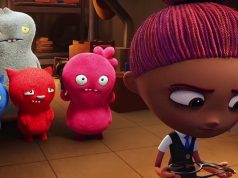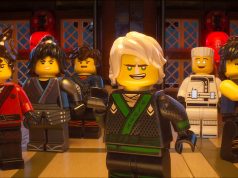The Bratz are a line of big-headed, fashion-conscious dolls aimed at tween girls, who are past the age where they want to play with Barbies but just getting to the age where they want to live out their slutty, materialistic fantasies vicariously through playthings. The Bratz dress provocatively and have been the source of controversy among parents who feel they encourage a too-early sexualization of young girls. One of the Bratz toy sets has the Bratz sneaking out of the house to go on blind dates with boys. Hooray for teaching skankiness at an early age!
The Bratz’ first live-action movie, cleverly titled “Bratz” and evidently inspired by the animated TV series of the same name, is appalling and horrific, but for entirely different reasons. The producers have wisely toned down the trampiness of the girls’ outfits, perhaps realizing that what garners a few raised eyebrows when it’s worn by a piece of plastic would garner torch-wielding mobs if it were worn by actual young girls (or even 20-year-old actresses playing young girls). And the Bratz’ fondness for buying clothes is not played up as heavily as you might expect, either, though that’s not to say there’s not still plenty of materialism to be found. MTV and MySpace are name-checked several times each.
No, the Bratz movie is bad in other ways — not for its message or values, but for simply being a flat-out awful abortive trainwreck of a disastrous pile of worthless stupid garbage of an utter mess of a movie, even by the low, low standards of Movies Based on Toys. Every turn of the wandering, aimless story is ill-conceived, the jokes fall flat, and the characters are as plastic and fake as their Toys R Us counterparts.
This last point is particularly delicious, since the movie’s message is that you should be yourself, be unique, and not worry about fitting in with the crowd. Yet the heroines — a quartet of lifelong friends who find themselves drifting into separate cliques when they reach high school — are adorned with personality traits as randomly and as inauthentically as you might put clothes on a doll. You can almost hear the little girls playing with the characters in their Let’s Make a Bratz Movie Playset: “Let’s make this one really good at singing … and journalism!” “I want this one to be an expert scientist — and a brilliant fashion designer!” And how do we convey that those characters really ARE those things? Mostly by having them say so. For example, one girl in the movie keeps mentioning that she’s in the journalism department, yet we never actually see her do anything journalism-y, nor does she hang out with the journalism crowd. If she never said it, we’d never know.
The friends are identified as follows: Yasmin (Nathalia Ramos) is Mexican, a good singer (but plagued with stage fright), and keen on journalism (allegedly). Jade (Janel Parrish) is Asian, good at math and science, has overachieving parents, and secretly wants to be a fashion designer. Sasha (Logan Browning), the black one, loves cheerleading and has divorced parents. Cloe (Skyler Shaye), the blond white girl, is klutzy but is also great at soccer. She’s also really good at having a single mom and being poor; however, those skills don’t emerge until very late in the film, at which point they’re mentioned as if we should have known them all along.
The film starts with their first day at Carry Nation High School, named for the famous hatchet-wielding anti-alcohol activist of the early 20th century. The principal, Mr. Dimly (Jon Voight, wearing fake nose and ears so as not to be recognized), reads a book called “How to Run a Prison.” His perky princess daughter, Meredith (Chelsea Staub), is student body president and his chief supporter. They both want the school to be neatly organized into distinct cliques, as that makes everyone easier to control. There is oppressive signage everywhere about not littering and not running and not speaking out of turn.
Clearly some attempt was being made here to inject satire into the story. It is rather funny to see grumpy-faced Carry Nation, ax in hand, on all the school’s logos, I’ll give them that. Unfortunately, not enough is done with the satirical elements to make them effective. The target audience won’t catch them, and the grown-ups … well, I guess they’ll point out that they’re not very effective. I’m a grown-up, and that’s what I just did.
Never mind that stuff. The point is, the girls have always been a foursome, and now that they’ve entered high school, they’re splitting up into cliques. Then two years pass. (Yes, two years!) Suddenly they’re juniors, and they haven’t really spoken since freshman year, their extracurricular activities keeping them apart despite their best efforts. Then one day there’s a huge food fight during lunch, and for some reason that results in the four Bratz vowing to get back together and never let their cliques separate them again!
This enrages Meredith, who doesn’t like the idea of people not being in cliques. So she throws a huge Sweet Sixteen party for herself (her second one, since she’s been 16 for several months already) and invites people in a way that indicates they have to be part of a group to attend. It has something to do with popping a balloon, and in the balloon is a slip of paper that says “Cheerleading” or “Journalism (alleged)” or whatever. I didn’t really understand it. Anyway, the Bratz (who aren’t called “Bratz” yet, by the way, I forgot to tell you that part) see through Meredith’s transparent attempt to keep them in line, and they decide to just not go to the party.
But then it turns out that Cloe’s mom, who you’ll recall is poor and runs a catering business — oh, did I not mention her catering business? Must be because the movie never mentioned it until now, either — well, she was hired to cater Meredith’s party, and all her employees have bailed out, which means the Bratz have to pitch in and help out by being waitresses at the party. How embarrassing! Even more embarrassing, they’re supposed to wear clown costumes! But don’t worry! One of of the girls — I don’t know, Jade? Cloe? Kitanna? Dikoda? — is a great seamstress, and she alters their clown costumes into eye-catching, fashion-forward ensembles that make them the hit of the party. Crisis averted!
Then for some reason there’s a talent show at school. “The only way to get everyone back together is to win the talent show!” one of the girls declares, as if stating the obvious, when in fact the connection between winning the talent show and getting everyone back together is tenuous at best. This contest is held every year, and Meredith (who fancies herself a singer) always wins. That’s because as student body president, she and she alone gets to decide who competes in the show, and she rejects any act that might give her a run for her money. Having failed in her efforts to separate the not-called-Bratz-yet, she tries to blackmail them into dropping out of the show … which is superfluous, since, as I mentioned, she has the power to just kick them out for no reason.
Her blackmail material is a video-phone recording of Yasmin (the Mexican girl) dancing around her bedroom with her mother (Lainie Kazan) singing — I kid you not — “La Cucaracha.” Now, it seems to me that if you don’t want people to think that you’re an embarrassing ethnic stereotype, then maybe you, as a Mexican girl, shouldn’t dance around singing “La Cucaracha.”
I should also mention that in the first scene set at this house, Yasmin comes downstairs for breakfast and sitting at the kitchen table is … a mariachi band, complete with instruments. Surely this is a remnant from a deleted scene, as it is never explained why a fricking mariachi band is sitting at the kitchen table, and why no one says anything about them.
Then there’s the talent show, and finally Meredith calls them brats, which they interpret as “Bratz,” goodness knows why. They sing a song about having a positive attitude. It involves legions of back-up dancers and live musicians, all of whom appear more or less out of nowhere. Maybe the mariachis were among them.
Oh yeah, earlier Yasmin meets a cute boy named Dylan (Ian Nelson) who is in the jock clique, but he used to be in the band clique, back before he went deaf. He’s newly deaf. But he’s super-good at reading lips — so good that you don’t even have to be facing him when you talk and he’ll still know what you’re saying. Also, he can put his hands on a speaker and feel the vibrations of your singing voice and be able to tell that it’s beautiful. He is a magical deaf boy indeed. I don’t know why he’s in the movie, but since he contributes to its overall idiocy, I thought I’d mention him.
Surprisingly, this movie has a director. His name is Sean McNamara. He made a Hilary Duff movie a few years ago called “Raise Your Voice,” which was also a) about teenage girls and music, and b) lousy. Stick to your strengths, I guess.
(The film allegedly had a writer, too, but I’m going to refrain from identifying him or her until I can get corroboration that it’s not a hoax and that there was, in fact, a script.)
I could go on all day about this film’s implausible scenes, subplots that don’t go anywhere, and misguided attempts at teaching valuable lessons. But I’ll close by just saying this: Even though you assume a “Bratz” movie is going to be bad, you have NO IDEA just how bad this one is. It’s bad in ways I hadn’t expected, ways that surprised me and gave me a headache. It’s definitely one of the worst moviez of the year.
F (1 hr., 42 min.; )





